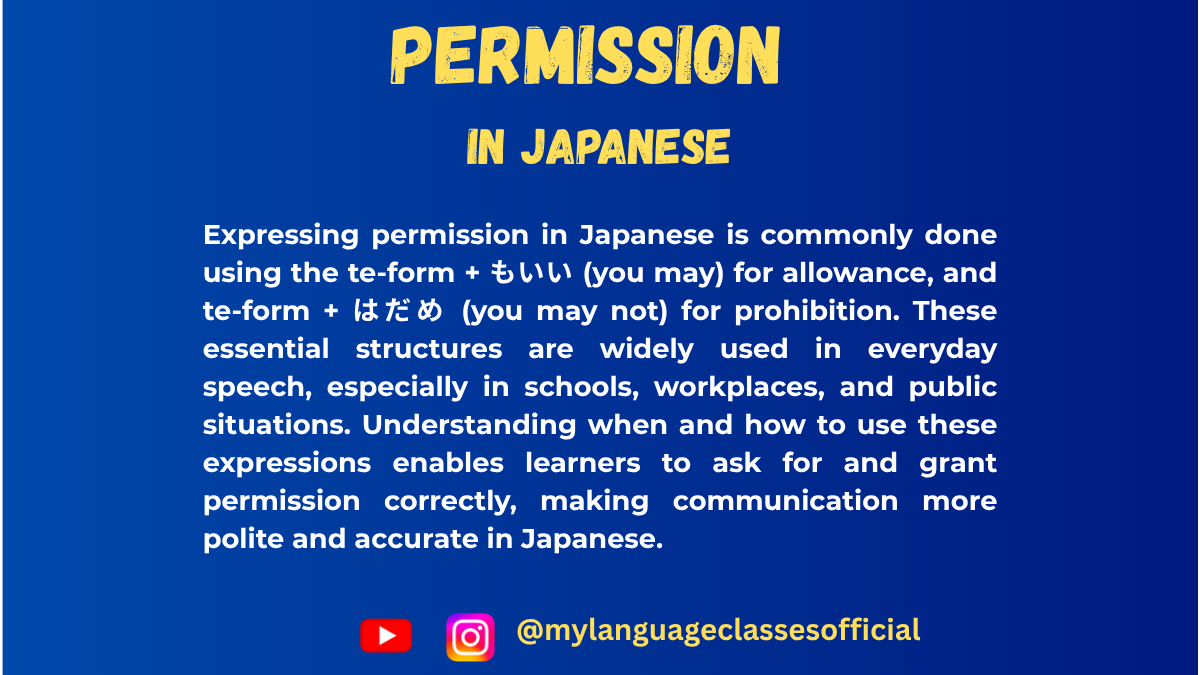Your cart is currently empty!
Expressing Obligation and Permission in Japanese

Obligation and Permission in Japanese
Understanding how to express obligation and permission is crucial when learning Japanese. These concepts allow you to navigate everyday situations, from asking for approval to understanding rules. In this blog, we’ll explore two essential structures: Verb te-form + もいい (“May”) and Verb te-form + はだめ (“Must not”).
1. Verb te-form + もいい: Expressing Permission (“May”)
The structure Verb te-form + もいい is used to ask for or give permission to do something. It translates to “May I…?” or “You may…” in English.
How It Works:
- Conjugate the verb into its te-form.
- Add もいい to grant or inquire about permission.
Examples:
- ここでたべてもいいですか?
(Koko de tabete mo ii desu ka?)
“May I eat here?” - はい、たべてもいいです。
(Hai, tabete mo ii desu.)
“Yes, you may eat.” - しゃしんをとってもいいです。
(Shashin o totte mo ii desu.)
“You may take a photo.”
Casual Form:
- ここにすわってもいい?
(Koko ni suwatte mo ii?)
“Can I sit here?”
2. Verb te-form + はだめ: Prohibiting Actions (“Must not”)
The structure Verb te-form + はだめ is used to express prohibition. It translates to “You must not…” in English.
How It Works:
- Conjugate the verb into its te-form.
- Add はだめ to indicate that an action is not allowed.
Examples:
- ここでたばこをすってはだめです。
(Koko de tabako o sutte wa dame desu.)
“You must not smoke here.” - さわってはだめです。
(Sawatte wa dame desu.)
“You must not touch.” - ここにゴミをすててはだめです。
(Koko ni gomi o sutete wa dame desu.)
“You must not throw trash here.”
Casual Form:
- ここでねてはだめ。
(Koko de nete wa dame.)
“You can’t sleep here.”
3. Combining Both Structures
These expressions often come in handy together when discussing what is allowed and what is prohibited. For example:
- このほんをよんでもいいですが、かえしてはだめです。
(Kono hon o yonde mo ii desu ga, kaeshite wa dame desu.)
“You may read this book, but you must not take it home.”
4. Cultural Notes
In Japan, these expressions are frequently used in formal and informal situations. Here are some important points to remember:
- When asking for permission, it’s polite to add ですか or いいですか to maintain politeness.
- はだめ is direct, so in formal situations, you might soften it with phrases like いけません (ikenai) for “not allowed.”
5. Practice Time
Try forming sentences using these structures:
- Ask if you can use your phone in class.
- Prohibit someone from running in the hallway.
- Give permission to drink coffee at your home.
Post your sentences in the comments, and I’ll correct them!
Mastering these grammar points will make you more confident in your Japanese conversations. Whether you’re asking for permission or ensuring you follow rules, these structures are indispensable for fluency.
If you enjoyed this lesson, be sure to check out more posts like this on my blog at My Language Classes. Don’t forget to subscribe my YouTube channel and follow me on Instagram for the latest language learning tips and lessons. Leave a comment below to share your thoughts, or ask any questions you have about nouns.
Happy learning! 😊
📚 Continue Learning Japanese
Vikas Kumar is a dedicated language educator, content creator, and digital entrepreneur, best known as the co-founder of My Language Classes and The Curious Mind. With a strong focus on helping learners achieve fluency in English, Spanish, and Japanese, he has guided audiences worldwide through a diverse range of resources, including in-depth blog articles, engaging YouTube tutorials, and comprehensive Books.
Through My Language Classes, Vikas has built a thriving multilingual learning platform that serves students, travelers, and professionals eager to master communication skills for personal, academic, and professional success. His expertise extends to exam preparation for internationally recognized certifications such as JLPT, DELE, IELTS, and TOEFL, enabling learners to achieve tangible, career-enhancing results.
As the founder of The Curious Mind, he also explores broader areas of knowledge, including self-help, motivation, modern learning strategies, and thought-provoking insights on life and personal growth. His work blends practical teaching methods with a deep understanding of learner psychology, making complex concepts accessible and engaging.
Driven by a mission to make high-quality education accessible to all, Vikas continues to expand his reach across multiple platforms, including YouTube, blogs, eBooks, and social media communities, inspiring thousands to learn, grow, and embrace lifelong learning.


Leave a Reply